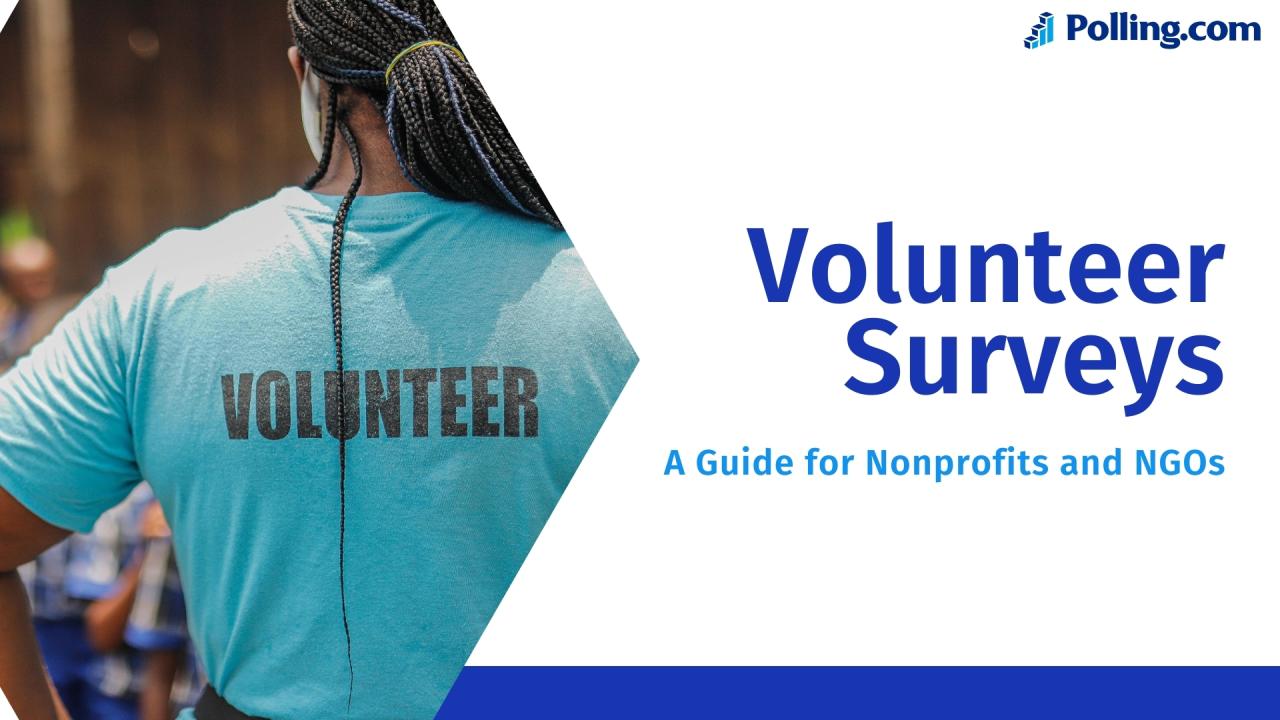
Volunteer Surveys: A Guide for Nonprofits and NGOs
Behind every successful nonprofit or community initiative is a dedicated group of volunteers.
They give their time, energy, and expertise. But how often do organizations stop to ask about their experience? That’s where volunteer surveys come in.
These surveys are more than a formality; they’re a direct line to the people who keep your programs running.
The feedback you collect helps you uncover what’s working, where there’s friction, and how you can make volunteering more rewarding.
And the payoff is real: stronger retention, better recruitment, and happier volunteers who feel connected to your mission.
Today, creating and analyzing these surveys is easier than ever with platforms like Polling.com, which make it easy to collect customer feedback and volunteer insights in a way that’s fast, flexible, and actionable.
Understanding Volunteer Surveys
To get the most out of them, it helps to first understand what volunteer surveys are and why they’re such a powerful tool.
What Are Volunteer Surveys
At their core, volunteer surveys are short questionnaires designed to gather insights from people who contribute their time and skills.
They’re different from donor or customer surveys because they zero in on the volunteer experience, covering everything from motivation and expectations to role clarity and overall satisfaction.
Nonprofits, NGOs, event organizers, and local community groups all use them in different ways.
A nonprofit might want to improve onboarding, while an event team could be focused on logistics.
No matter the context, the goal is the same: listen to your volunteers and turn their feedback into better programs.
Why Volunteer Feedback Matters
Your volunteers aren’t just helping hands; they’re advocates for your mission. If they have a great experience, they’ll come back, bring friends, and speak positively about your work.
If they don’t, recruitment gets harder and retention drops.
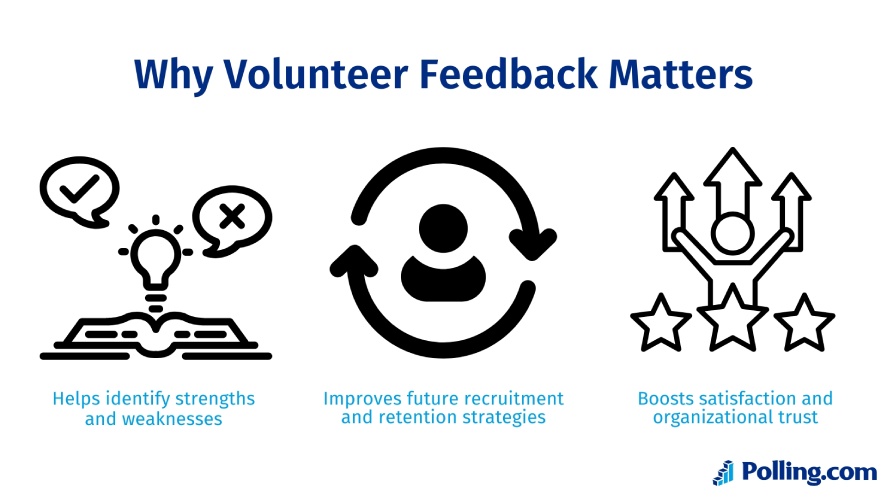
By actively asking for feedback, you can:
- Spot areas where your program shines and where it struggles
- Build smarter recruitment and retention strategies
- Increase satisfaction, making volunteers more likely to return
- Strengthen trust and transparency within your community
In short, feedback turns guesswork into strategy.
Instead of assuming what volunteers want, you’ll know, and that clarity helps you create programs that strengthen volunteer engagement and keep people involved long term.
Benefits of Conducting Volunteer Surveys
Asking volunteers for feedback isn’t just about collecting customer feedback and volunteer opinions; it’s about strengthening the relationship between your organization and the people who keep it running.
When surveys are done well, they give you a clearer picture of what’s working, what isn’t, and how to build an experience that makes volunteers want to stay involved.
Better Volunteer Retention
Keeping volunteers engaged is often more challenging than recruiting them in the first place.
Surveys can uncover what motivates people to return, whether that’s recognition, skill-building, or simply feeling connected to the mission.
At the same time, they highlight friction points, like unclear roles or overwhelming schedules that may cause drop-offs.
By addressing these issues early, you create a more positive and supportive environment that encourages long-term commitment.
Improved Program Effectiveness
Volunteers see your programs from the inside out, and their perspective is invaluable.
Their feedback can reveal inefficiencies in workflows or suggest ways to make tasks more meaningful.
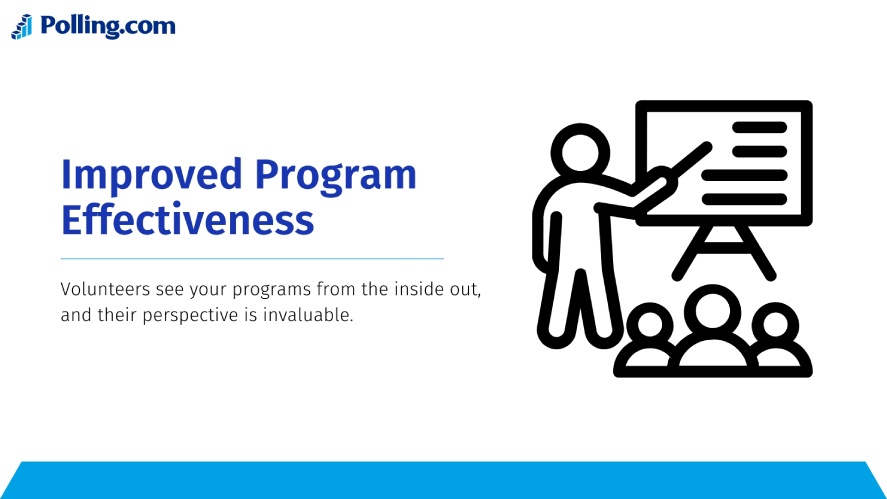
For example, someone with a background in teaching might thrive in training new recruits instead of doing back-office work.
Aligning responsibilities with skills and interests not only boosts performance but also ensures volunteers feel their contributions are valued.
Data-Driven Decision Making
Survey responses add up to more than individual opinions; they form a body of evidence you can use to guide strategy.
Trends in the data might show, for instance, that training sessions are too short or that communication between shifts could be smoother.
With this kind of insight, decisions about scheduling, onboarding, or recognition programs are no longer guesses.
Instead, they’re grounded in real experiences, making your organization more adaptable and resilient over time.
When and How to Conduct Volunteer Surveys
Even the best volunteer survey questions, no matter the type of survey questions you choose, can fall flat if you send them at the wrong time or in the wrong format.
To get meaningful results, it’s important to be intentional about when you ask for feedback and how you deliver the survey.
Timing Your Surveys
Different moments in the volunteer journey call for different types of insights.
Pre-engagement surveys, for example, can uncover motivations before someone event starts.
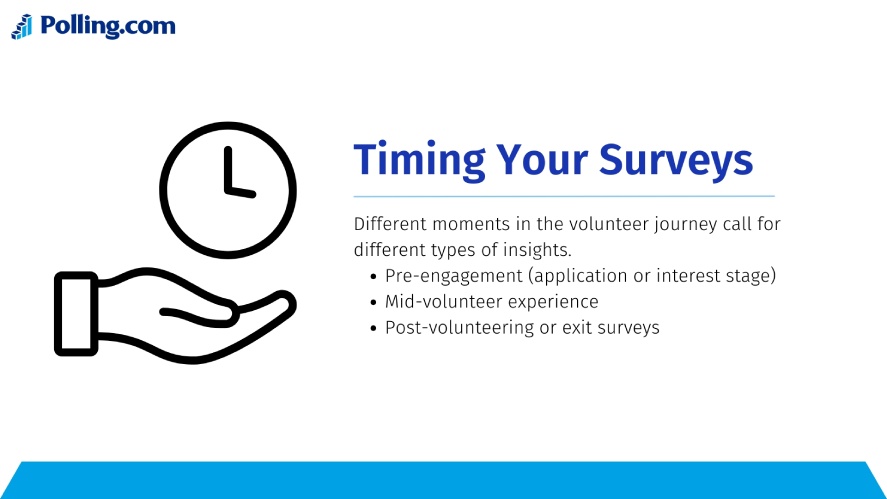
Mid-experience check-ins give you the chance to refine their current role while they’re still active.
And post-volunteering or exit surveys capture valuable reflections about the overall experience, helping you improve for the next group of volunteers.
Choosing the Right Format
Format plays a big role in how much feedback you’ll actually receive.
Online surveys are often the easiest to distribute and analyze, especially if you’re working with a large group.
In on-site events or settings where digital access is limited, paper forms or shared tablets may be more practical.
And depending on your goals, you may also decide whether to keep responses anonymous to encourage candor or identifiable so you can follow up personally.
Sample Questions for Volunteer Surveys
Good survey questions don’t just fill space; they open the door to honest feedback.
If you’ve ever wondered about the best questions to ask for surveys, below are the sample survey questions for volunteer surveys.
Pre-Volunteer Questions
Before someone starts, it’s helpful to learn what drew them to your cause and what they hope to gain. This sets expectations on both sides.
You might ask:
- What motivated you to volunteer with us?
- What are your goals or expectations?
These questions help you understand whether people are looking for skill-building, community connection, or simply a chance to support a cause they believe in.
During Volunteering
Once volunteers are active, check in to make sure their role is clear and meaningful. This is where you catch small frustrations before they grow into bigger problems.
For example:
- Are your tasks clearly explained?
- Do you feel your contributions are making an impact?
Midway feedback allows you to adjust responsibilities, improve training, or provide extra support where needed.
Exit or Post-Engagement
When a volunteer wraps up, their perspective is invaluable. Exit surveys capture both the highlights and the gaps in their experience.
Here are a few survey questions examples you can use:
- What did you enjoy most about your experience?
- How can we improve our volunteer program?
- Would you consider volunteering with us again?
These reflections help refine your programs for future volunteers, much like how customer experience survey questions help improve service quality, while also signaling that you value their time and input.
Analyzing and Using Volunteer Survey Data
Collecting survey responses is only half the job. The real value comes from turning that feedback into practical volunteer retention insights that strengthen your volunteer program.
Identifying Key Insights
When reviewing survey results, start by looking for patterns.
Do multiple volunteers mention unclear instructions, or praise a particular event? These recurring themes in qualitative responses point to what’s working and what needs attention.
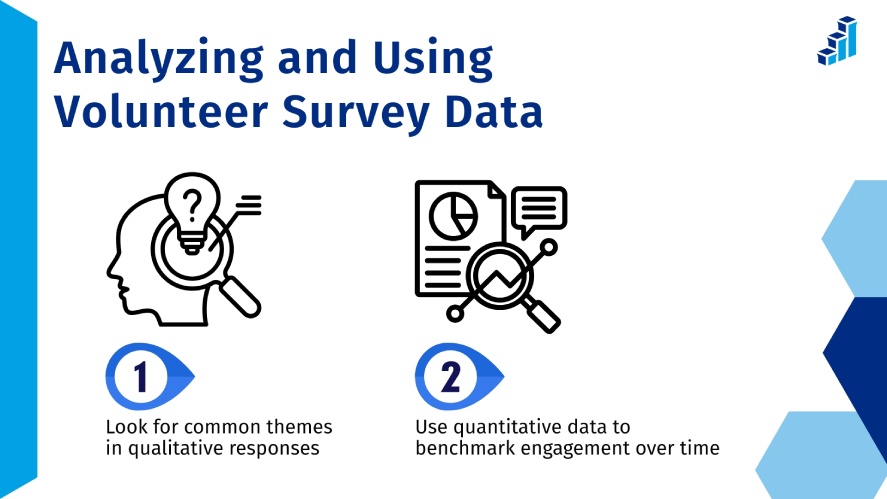
On the numbers side, track quantitative data such as satisfaction scores or participation rates.
For example, if your average volunteer satisfaction survey rating drops from 4.6 to 4.1 over two surveys, that’s a sign something has shifted.
Likewise, a rise in volunteer retention from 60% to 75% can confirm that recent changes are moving the program in the right direction.
Taking Action on Feedback
Insights lose their power if they sit unused.
So, share survey findings with your team and, when appropriate, with the volunteers themselves.
Showing them that their input led to real improvements builds trust and keeps people engaged.
Depending on what you learn, you might refine training materials, provide better tools, or adjust schedules to reduce burnout.
Even small chances, like clearer communication before shifts, can have a big impact on volunteer satisfaction.
Tools for Creating Volunteer Surveys
Having the right tools makes it easier to gather, analyze, and act on volunteer feedback.
Why Use Polling.com
Polling.com is a strong choice for nonprofits and community groups because it’s designed with ease of use in mind.
The platform comes with pre-built volunteer survey templates, so you don’t have to start from scratch.

It also offers analytics dashboards and real-time data tracking, helping you quickly spot trends as responses come in.
Most importantly, it’s built to support organizations that run on limited time and resources, making it a practice solution for busy teams.
Comparing Other Survey Tools
Other platforms like SurveyMonkey, Typeform, and Google Forms are also widely used.
SurveyMonkey is robust and feature-rich, but it can get expensive for larger teams. Typeform shines with its modern, conversational design, but may feel more suited to marketing than volunteer management.
Google Forms is free and simple, but it lacks advanced reporting and automation features.
Compared to these, Polling.com balances simplicity, nonprofit-friendly pricing, and built-in analytics. All of these make it the top choice for most volunteer programs.
Read More: Free Survey Tools for Nonprofits: Boost Feedback & Impact
Real Examples from Volunteer Organizations
To see how volunteer engagement surveys make a tangible difference, here are a couple of real-world examples from organizations that turned feedback into action.
Nonprofit Case Study
A mid-sized nonprofit that relied heavily on weekend volunteers noticed high turnover after just a few months.
Through an exit survey, they discovered many people felt burned out by long shifts and unclear responsibilities.
By shortening shifts to four hours and introducing a buddy system for new recruits, the organization not only reduced early drop-offs but also improved retention by nearly 20% over the next year.
Volunteers also reported feeling more supported and satisfied in follow-up surveys.
Community Program Example
A local after-school program used mid-engagement surveys to ask volunteers whether they felt informed about daily activities.
Over half said they often received updates too late, which created confusion. The coordinators responded by setting up a weekly text reminder system and a shared calendar.
Within two months, volunteers rated communication clarity 30% higher, and coordinators saw smoother handoffs between shifts.
Frequently Asked Questions
Aim to collect feedback at least once per project or engagement cycle. For long-term programs, a quarterly check-in helps you spot trends early.
Anonymity usually encourages more honest feedback, especially for exit surveys. However, allowing an optional name field can be helpful if you want to follow up on specific concerns.
Nonprofits typically see response rates between 30-50%. With clear communication and reminders, aiming for 40% or higher is realistic.
It’s better to adjust your questions for each program or role. A volunteer participation survey for one-time event volunteers should look different from one for long-term mentors.
Keep it short (under 10 questions), mobile-friendly, and let volunteers know why their input matters. For example, share how past feedback led to changes in scheduling or training.
Conclusion
Treating surveys as part of your volunteer strategy can turn feedback into progress.
From improving onboarding to boosting retention, data-driven insights help nonprofits adapt and thrive.
When volunteers know their voices matter, they’re more likely to stay engaged and become long-term champions of your mission.
Ready to improve your volunteer programs with real insights?
Start creating custom volunteer surveys with Polling.com today — it’s free to try and built for nonprofit impact.
